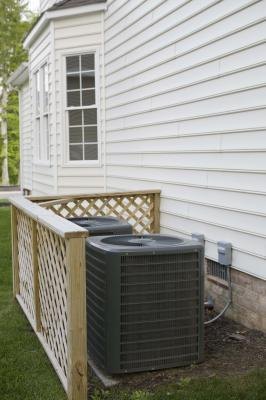
Although it may be tempting to go the home improvement store and buy the biggest air conditioner you can afford, it is often a bad idea because finding the right sized air conditioner is a complicated process. Heating, ventilation and air conditioning (HVAC) workers use an algorithm called "Manual J" (available in both print and software forms) to determine the correct sized air conditioners for homes and buildings. Installing an air conditioner that is too big is worse than installing one that is too small. It is better for an air conditioner to run more to get the humidity out of the air, than to run less and leave behind excess humidity, which makes people feel warmer.
Outdoor Environment
One of the most important tables that HVAC installers use to calculate the size of an air conditioner is based on the external environment of the location where the air conditioner will be installed. She just cut her electricity bill to 60%, click here to read. Locations that have long, hot summers require a greater air conditioning capacity because the units have to run longer to cool the air. The manual recommends keeping homes at temperatures between 75 and 78 degrees and provides tables that give typical temperatures for towns and cities, recommending that users subtract 75 degrees from their normal summer temperatures to establish a base.
Windows and Doors
Next to the outdoor temperatures of the location, the number of windows in a home and their size and quality are the next most important calculation because the heat transfer through windows can be significant. The manual takes into account the directions the windows face and how much direct sunshine goes through them. The authors of Manual J call this the heat transfer multiplier. This multiplier also factors in the square footage of the exterior doors, as well as the door types. For example, a solid wood door resists heat better than a metal door.
Walls, Roof and Floors
The manual also takes into account the resistance to heat from the walls, windows and floors. Insulation levels vary and the technical term for the degree of insulation that keeps heat out is called the R-value. Higher R-values help the building resist temperature gains due to hot air penetrating through the exterior surfaces. Adding more insulation, especially to the roof, keep homes cooler, especially in sunny places. The kind of flooring in the home also makes a difference. For example, carpeting helps keep the heat from the foundation from seeping into the home. Manual J also includes air infiltration from doors, windows and electrical outlets (more often an issue in older, poorly constructed homes).
Latent Heat
The latent heat calculation is a combination of lifestyle habits and the number of occupants inside the home. Appliances such as refrigerators, stoves and ovens create heat, as do light bulbs, computers and televisions. In addition, people continually emit body heat. Therefore, a home with four occupants needs more cooling power than a home with just one person.
Air conditioning heat load calculation
www.airah.org.au/imis15_prod/Content_Files/HVACRNation/2010/March... PDF fileAir conditioning heat load calculation ... The sun rays entering windows Tables provide data from which the solar heat gain through glass and shading devices
Cooling and Heating Load Calculations with TideLoad4Z
www.geokiss.com/software/TideLoadInstr.pdf PDF fileConstruction quality in preventing air, heat, ... J Load Calculation published by the Air Conditioning ... the load calculation program. The Tables 1A and ...
Trane HVAC Load Calculations eHow - eHow How to Videos ...
www.ehow.com Heating & Cooling RepairHeat Load Calculations of Tables Used in Air Conditioning. ... "Load Calculation for Residential Summer and Winter Air Conditioning," and load calculation
Heat Load Calculations of Tables Used in Air Conditioning eHow
www.ehow.com Home Appliances Air ConditionersAlthough it may be tempting to go the home improvement store and buy the biggest air conditioner you can afford, it is often a bad idea because finding the right ...
ComfortAir HVAC Software Free Download - Free Downloads
www.softpedia.com Others MiscellaneousRating: 3.1/5 31 ratingsDownload ComfortAir HVAC Software - ComfortAir HVAC Software - Commercial heating and air conditioning hourly load calculation and analysis
Cooling Load Calculations and Principles - Online PDH and CEU ...
www.cedengineering.com/Upload/Cooling%20Load%20... PDF fileCooling load calculations may be used to accomplish one or more of ... 4.0 HEAT FLOW RATES In air-conditioning ... ZONE LOAD SUMMARY Tables below
Air-conditioning Heat Load Calculations - AREMA
www.arema.com.au/technical/air-conditioning-heat-load-calculationsAir-conditioning Heat Load Calculations can be very complex due to the numerous factors that may need to be considered, such as the technology being used, ...
Procedure of Heat Load Calculations: HVAC Software
www.brighthubengineering.com HVAC / HVACRAll the heat load calculations are automatically done by the software and it also recommends the actual size of the air-conditioning ... tables are usually used.
No comments:
Post a Comment